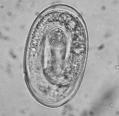Difference between revisions of "Dictyocaulus arnfieldi"
Jump to navigation
Jump to search
| (19 intermediate revisions by 3 users not shown) | |||
| Line 1: | Line 1: | ||
| − | + | == Lungworm == | |
| − | + | === ''DICTYOCAULUS ARNFIELDI'' === | |
| − | |||
| − | |||
| − | |||
| − | |||
| − | |||
| − | |||
| − | |||
| − | |||
| − | |||
| − | |||
| − | |||
| − | |||
[[Image:Dictyocaulus arnfieldi.jpg|thumb|right|150px|''Dictyocaulus arnfieldi'' from horse faeces - Joaquim Castellà Veterinary Parasitology Universitat Autònoma de Barcelona]] | [[Image:Dictyocaulus arnfieldi.jpg|thumb|right|150px|''Dictyocaulus arnfieldi'' from horse faeces - Joaquim Castellà Veterinary Parasitology Universitat Autònoma de Barcelona]] | ||
| − | + | ==== General ==== | |
| + | *Lungworm of equidae; adult worms found in smaller bronchi. Frequently incriminated as the cause of a chronic cough. | ||
| − | == | + | ==== Morphology and Life-Cycle ==== |
| − | + | *Similar to lungworm in cattle, except: | |
| + | **embryonated eggs (80-100µm) passed in fresh faeces; and | ||
| + | **prepatent period = 12weeks. | ||
| − | == | + | ==== Epidemiology ==== |
| − | + | *Main source of infection = donkeys (remain infected for years) - contaminate horse pasture. | |
| + | *Infection can cycle in horses. | ||
| − | |||
| − | == | + | {| style="width:75%; height:200px" border="1" |
| − | |||
| − | + | ! | |
| + | !'''Horses''' | ||
| + | !'''[[Lungworm - Donkey|Donkeys]]''' | ||
| − | + | |- | |
| − | | | + | |'''Prevalence''' |
| − | | | + | |10-20% |
| − | | | + | |75% |
| − | + | |- | |
| + | |'''Adult worms''' | ||
| + | |Few | ||
| + | |Many | ||
| + | |- | ||
| + | |'''Eggs in faeces''' | ||
| + | |Often zero | ||
| + | |Many | ||
| + | |- | ||
| + | |'''Period of patency''' | ||
| + | |<8months | ||
| + | |5+ years | ||
| + | |- | ||
| + | |'''Clinical signs''' | ||
| + | |Sometimes | ||
| + | |Rarely | ||
| + | |} | ||
| − | + | '''NOTE''': Clinical signs - chronic cough at rest or during exercise, single animal or group of horses, autumn or early winter. | |
| − | + | *''Dictyocaulus arnfieldi'' causes [[Respiratory Parasitic Infections - Pathology#Dictyocaulus arnfieldi|cough in horses]] | |
| + | ==== Pathogenicity ==== | ||
| + | *Raised areas of over-inflated pulmonary tissue (several cms in diameter) surrounding small bronchus containing worms and mucopurulent exudate. | ||
| + | *Hyperplastic bronchial epithelium. | ||
| + | *Peribronchial "cuffing". | ||
| − | + | ==== Diagnosis ==== | |
| + | *Clinical signs. | ||
| + | *Grazing history (donkey contact or shared grazing). | ||
| + | *Faecal examination (only detects patent infections = small proportion of lungworm infections in horses): | ||
| + | **process sample immediately = McMaster method, embryonated eggs | ||
| + | **process sample later = Baerman technique, larvae with tail spine. | ||
| + | *Tracheobronchial washings (large eosinophils). | ||
| + | *Response to anthelmintic treatment (e.g. resolution of clinical signs = retrospective diagnosis). | ||
| − | [[Category: | + | ==== Control ==== |
| − | [[Category: | + | *Do not keep horses on pastures grazed by donkeys (potential carriers). |
| + | *Treat donkeys with appropriate anthelmintic in spring if grazed with horses. | ||
| + | [[Category:Trichostrongyloidea]][[Category:Horse_Nematodes]] | ||
Revision as of 10:52, 21 May 2010
Lungworm
DICTYOCAULUS ARNFIELDI
General
- Lungworm of equidae; adult worms found in smaller bronchi. Frequently incriminated as the cause of a chronic cough.
Morphology and Life-Cycle
- Similar to lungworm in cattle, except:
- embryonated eggs (80-100µm) passed in fresh faeces; and
- prepatent period = 12weeks.
Epidemiology
- Main source of infection = donkeys (remain infected for years) - contaminate horse pasture.
- Infection can cycle in horses.
| Horses | Donkeys | |
|---|---|---|
| Prevalence | 10-20% | 75% |
| Adult worms | Few | Many |
| Eggs in faeces | Often zero | Many |
| Period of patency | <8months | 5+ years |
| Clinical signs | Sometimes | Rarely |
NOTE: Clinical signs - chronic cough at rest or during exercise, single animal or group of horses, autumn or early winter.
- Dictyocaulus arnfieldi causes cough in horses
Pathogenicity
- Raised areas of over-inflated pulmonary tissue (several cms in diameter) surrounding small bronchus containing worms and mucopurulent exudate.
- Hyperplastic bronchial epithelium.
- Peribronchial "cuffing".
Diagnosis
- Clinical signs.
- Grazing history (donkey contact or shared grazing).
- Faecal examination (only detects patent infections = small proportion of lungworm infections in horses):
- process sample immediately = McMaster method, embryonated eggs
- process sample later = Baerman technique, larvae with tail spine.
- Tracheobronchial washings (large eosinophils).
- Response to anthelmintic treatment (e.g. resolution of clinical signs = retrospective diagnosis).
Control
- Do not keep horses on pastures grazed by donkeys (potential carriers).
- Treat donkeys with appropriate anthelmintic in spring if grazed with horses.
